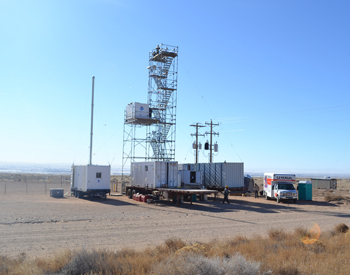A .gov website belongs to an official government organization in the United States.
A lock () or https:// means you've safely connected to the .gov website. Share sensitive information only on official, secure websites.
7 March 2012

Seen from the air, Utah's Uintah Basin is a bowl of dry, beige land surrounded by green mountains. This part of eastern Utah is remote and sparsely populated with about seven people per square mile (Washington, D.C., has more than 9,000).
But that doesn't mean the Uintah Basin's air is always pristine. During the last two winters, air quality monitors near oil and gas fields in the Uintah Basin have picked up episodes of ozone pollution far in excess of federal health-based standards in the least likely time – during winter.
"Ozone pollution is usually a problem in the summer and in cities," said Jim Roberts, CSD research chemist. "In the Uintah Basin, we have an unusual air quality situation, and it'll take some careful work to figure out what's going on."
The NOAA study targets high ozone pollution events in the western oil and gas fields. In late January 2012, Roberts and colleagues from the Utah Air Quality Division, other NOAA offices, the NOAA Cooperative Institute for Research in Environmental Sciences (CIRES) at the University of Colorado, and several other institutions launched the Winter Ozone Study in the Uintah Basin (UBWOS 2012). The team is peppering the basin with chemistry instruments for six weeks, to understand where the ingredients of ground-level ozone are coming from, and how wintertime temperature inversions and snow on the ground contribute to record-breaking ozone levels.
Understanding exactly why ozone pollution levels spike should help energy companies and local officials prevent poor air quality events or lessen their impact, said Brock LeBaron, deputy director of Utah's Division of Air Quality.
At high concentrations, ground-level ozone can cause severe respiratory effects in some people, and it damages crops, trees, and other vegetation. The Environmental Protection Agency (EPA) sets air quality standards for ozone pollution in the United States.
In the Uintah Basin last winter, ozone measurements periodically reached 140 parts-per-billion (averaged over 8 hours), exceeding the EPA's standard of 75 ppb and rivaling peak summertime levels measured in polluted cities.
"First and foremost, we need to protect public health," LeBaron said. "During these episodic conditions, ozone levels can get very, very high. Secondly, this issue has the potential to affect jobs in an area where the economy is based on energy. We want to be proactive, and maintain the ability to develop oil and gas resources in a responsible way."
Russ Schnell, a PSD scientist also involved in the study, first identified the wintertime ozone problem in rural Wyoming a couple years ago, also near gas and oil fields. His work was published in a paper in Nature Geoscience in 2009.
"We see exceedances when we have three things coinciding," Schnell said. "We need precursor pollutants that cook up in the sunlight to form ozone pollution; we need a meteorological pattern called an inversion, which traps pollutants down close to the surface; and we need snow on the ground. This only happens when there's snow on the ground."
It remains unclear what roles the snow plays – the white surface scatters sunlight, and light helps drive chemical reactions that lead to ozone formation. But the snow itself may also catalyze other chemical reactions that can contribute to ozone formation.
Similarly, scientists and air quality regulators in the region aren't sure where the "precursor pollutants" are coming from – these include classes of chemicals called volatile organic compounds and oxides of nitrogen, which combine to create ozone pollution. The possible sources for precursors are diverse: leaking gas pipes and oil storage tanks; on-road diesel engines used to support drilling; wastewater ponds associated with oil and gas exploration and development; a nearby power plant; even everyday traffic.
"During this six week study, we will collect a huge amount of data to help diagnose the roots and mechanisms of the ozone production problem," said Gabrielle Petron of NOAA and CIRES, and leader of a group operating a mobile laboratory being driven around the Uintah Basin to sniff out sources of the ozone-producing chemicals. "We hope this will be of use to decision makers and local residents."